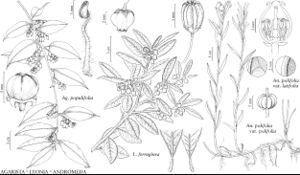Agarista
Gen. Hist. 3: 788, 837. 1834 ,.
Shrubs or trees. Stems erect; twigs glabrous. Leaves persistent; blade ovate, coriaceous, margins entire or serrate, plane, surfaces often multicellular, long-stalked stipitate-glandular-hairy, otherwise unicellular-hairy on midvein [covering abaxial surface]; venation reticulodromous (reticulum rather dense and with all orders ± equally prominent). Inflorescences axillary [terminal] racemes [panicles], 10–20-flowered, (produced just before flowering). Pedicels: bracteoles 2, near base to ± midpoint. Flowers: sepals 5, slightly connate, deltate; petals 5, connate for most of their lengths, white [red], corolla cylindric [urceolate], lobes short; stamens 10, included; filaments geniculate, flattened, hairy, without spurs; anthers without awns, dehiscent by elliptic pores; pistil 5-carpellate; ovary 5-locular; stigma (slightly exserted), truncate to capitate, obscurely lobed, (minutely papillose). Fruits capsular, subglobose to short-ovoid, (with unthickened sutures), dry. Seeds 120–250, narrowly oblong to pyramidal or angular-obovoid; testa cells elongate. x = 12.
Distribution
se United States, Mexico, Central America, South America, Africa, Indian Ocean Islands (including Madagascar)
Discussion
Agauria (de Candolle) Bentham & Hooker f.; Leucothoë D. Don subg. Agarista (D. Don ex G. Don) Drude
Species 31 (1 in the flora).
Selected References
None.
